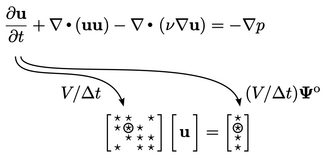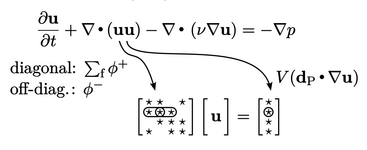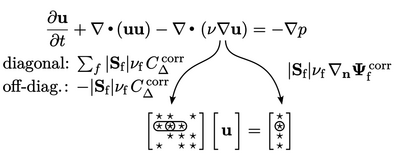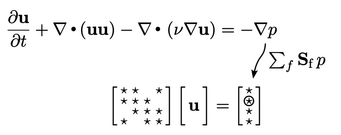3.24 Example of building a matrix equation
The previous sections describe methods to
discretise derivative and other terms in order to build a matrix
equation for a given physical equation. Let us demonstrate the
construction of a matrix equation, using the momentum conservation
equation from Sec. 3.23
as an example. It is
a vector equation, so produces 3 matrix equations for  ,
,  and
and
 .
.
The first term, the time derivative  , might be
discretised with the Euler scheme Eq. (3.21
). Matrix equations are
constructed in extensive
form as discussed in Sec. 3.6
. Hence, the
contributions from Eq. (3.21
) to matrix coefficients
, might be
discretised with the Euler scheme Eq. (3.21
). Matrix equations are
constructed in extensive
form as discussed in Sec. 3.6
. Hence, the
contributions from Eq. (3.21
) to matrix coefficients
 and source vector
and source vector  are scaled by cell volume
are scaled by cell volume  , i.e.
, i.e.  and
and  , respectively, as
illustrated below.
, respectively, as
illustrated below.

 , is discretised by
Eq. (3.8
). It
pre-calculates the volumetric flux
, is discretised by
Eq. (3.8
). It
pre-calculates the volumetric flux  , using
, using  interpolated by
Eq. (3.3
) with linear weights
Eq. (3.4
).
interpolated by
Eq. (3.3
) with linear weights
Eq. (3.4
).
The transported  might be discretised
using the linear upwind scheme described in Sec. 3.14
. The scheme first applies
upwind discretisation, which contributes outgoing positive fluxes
might be discretised
using the linear upwind scheme described in Sec. 3.14
. The scheme first applies
upwind discretisation, which contributes outgoing positive fluxes
 to
diagonal coefficients and negative fluxes
to
diagonal coefficients and negative fluxes  to off-diagonals. It
then adds an explicit contribution based on an extrapolated
gradient
to off-diagonals. It
then adds an explicit contribution based on an extrapolated
gradient  (see Sec. 3.14
). The gradient
(see Sec. 3.14
). The gradient
 is
usually calculated by Eq. (3.18
) with gradient
limiting from Sec. 3.16
.
is
usually calculated by Eq. (3.18
) with gradient
limiting from Sec. 3.16
.

 , is discretised by
Eq. (3.2
). It requires
, is discretised by
Eq. (3.2
). It requires
 ,
which is linearly interpolated from the cell centres. If the
surface normal gradient
,
which is linearly interpolated from the cell centres. If the
surface normal gradient  includes a non-orthogonal correction
includes a non-orthogonal correction
 ,
see Sec. 3.8
, then the term contributes to
,
see Sec. 3.8
, then the term contributes to
 and
and  , as shown below.
, as shown below.

 is calculated using Eq. (3.18
). Like all the
other terms described here, it is implemented in extensive form,
scaling by
is calculated using Eq. (3.18
). Like all the
other terms described here, it is implemented in extensive form,
scaling by  , so is calculated for each cell by the vector
, so is calculated for each cell by the vector
 .
The relevant component (
.
The relevant component ( ,
,  ,
,  ) of this vector is then applied to the
respective equation for
) of this vector is then applied to the
respective equation for  ,
,  and
and  .
.


